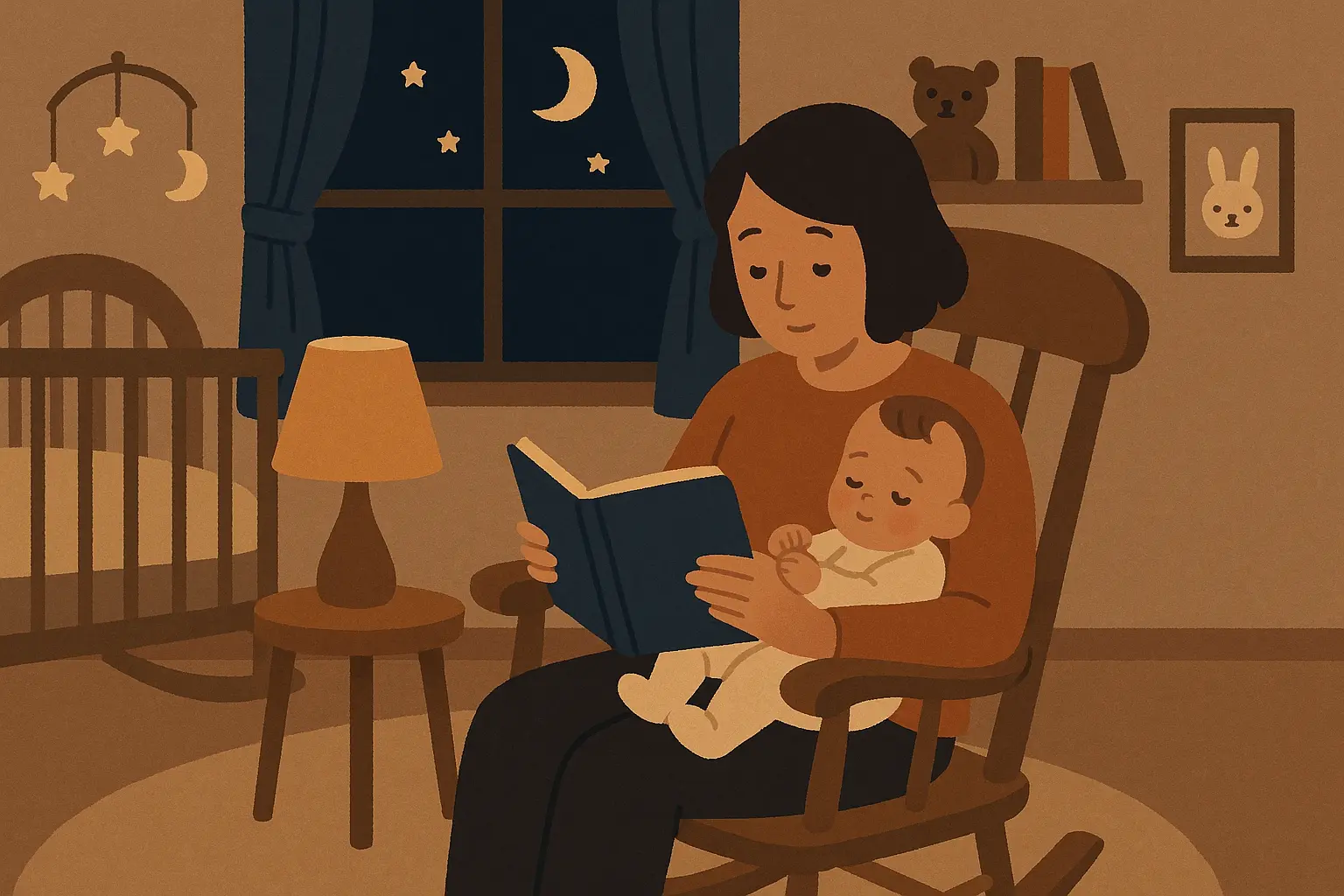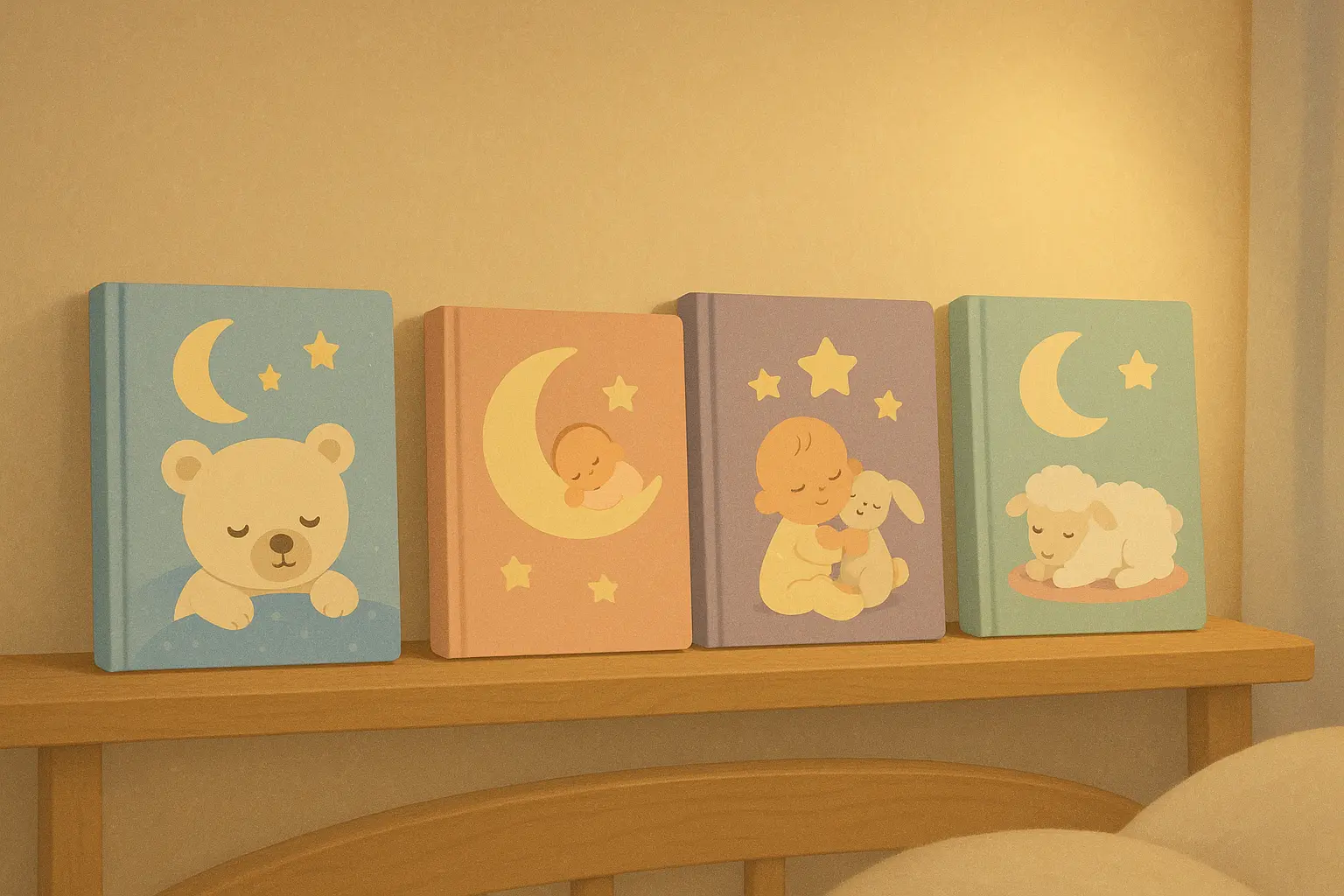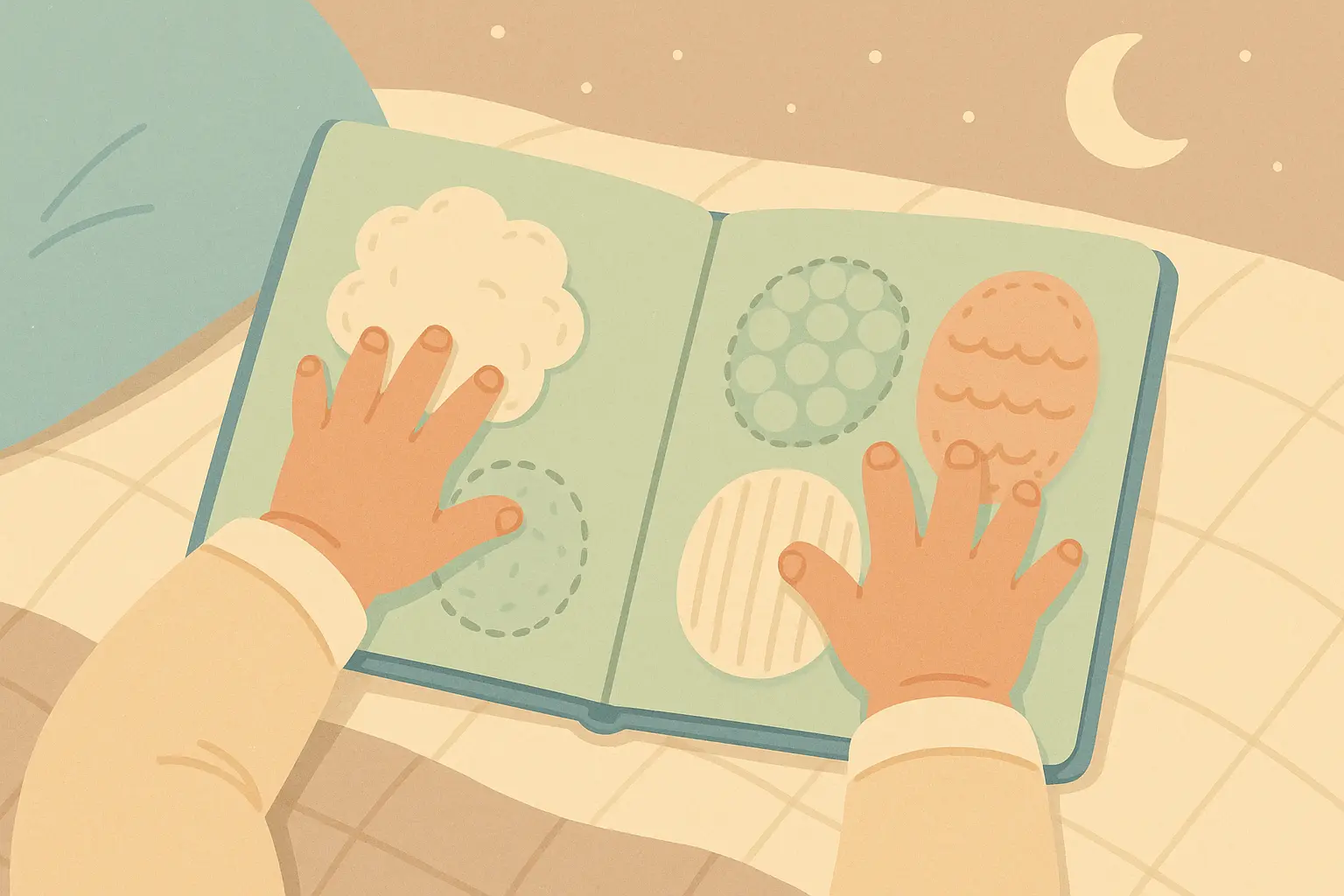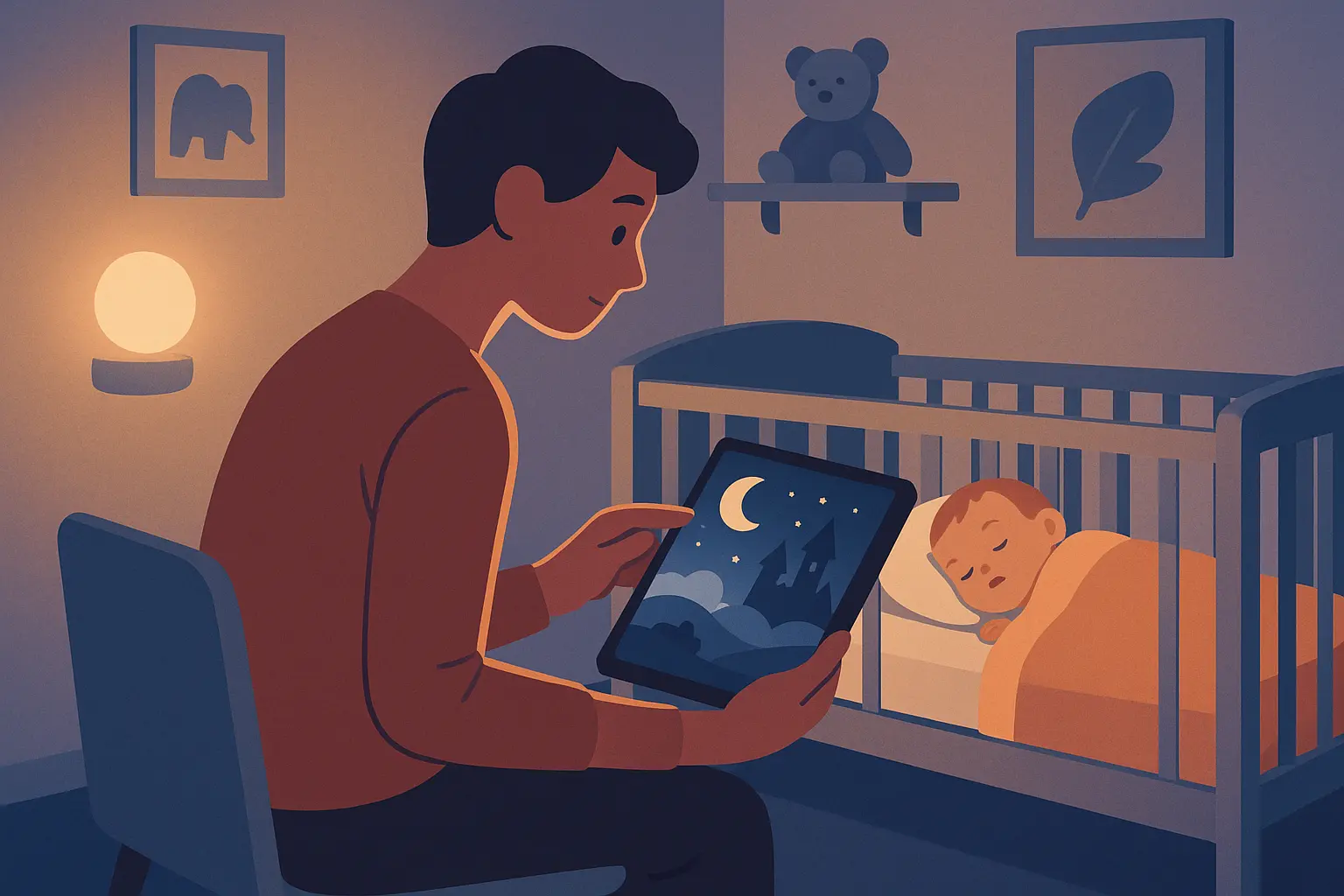Picture this: It’s 2 AM, you’re running on three hours of sleep from the past two days, and your baby is wide awake staring at you like you’re the most fascinating thing they’ve ever seen. Been there? Yeah, me too. That’s when I discovered something that changed everything – turns out most of us parents don’t start reading to our babies right away (guilty as charged!), but according to research from Bella Luna Family, only 10% of parents read to their children from infancy. Those early bedtime stories were actually building the foundation for language development, bonding, and positive sleep associations that would benefit us both for years to come.

Here’s what I wish someone had told me from the start: reading aloud from infancy helps newborns bond with their parents, promotes language development, and creates positive associations with books from the very start. Word sound awareness, listening skills, recognition of sounds and letters, and vocabulary all improve during the infant and toddler years through regular reading sessions. Your baby might not seem like they’re paying attention, but trust me – they’re absorbing every word.
Look, not all bedtime books are created equal. You need stories with soothing rhythms, the right length (because anything longer than 5 minutes and you’ll lose them), calming themes, and just enough interaction to keep them engaged without turning bedtime into playtime. For families looking to expand beyond traditional books, exploring bedtime stories for kids can provide additional options as your little one grows.
Table of Contents
-
What Makes a Perfect Baby Bedtime Story
-
Classic Lullaby Stories (5 stories)
-
Animal Friends and Nature Adventures (5 stories)
-
Family Love and Bonding Tales (5 stories)
-
Gentle Adventures and Imagination (4 stories)
-
Sensory and Interactive Stories (3 stories)
-
Musical and Rhythmic Stories (3 stories)
-
How Nairrate Can Create Your Perfect Bedtime Story
-
Final Thoughts
TL;DR
-
Most parents don’t start reading to babies early enough, missing crucial bonding and development opportunities
-
Perfect bedtime stories have soothing rhythms, run 3-5 minutes, focus on calm themes, and include gentle interaction
-
Classic lullaby stories work because of repetitive, comforting patterns that signal sleep time
-
Animal stories are basically baby magnets – they offer peaceful themes while letting you make silly sounds
-
Family bonding stories reinforce security and unconditional love (fair warning: some might make you tear up)
-
Sensory books will get destroyed through love – buy the board book versions
-
Musical stories work because familiar melodies trigger relaxation in both babies and parents
-
AI story generators can create personalized bedtime stories when you’re sick of reading the same five books every night
What Makes a Perfect Baby Bedtime Story
Here’s what I’ve learned the hard way about what actually works for bedtime stories. Your baby’s development stage matters way more than you might think, and understanding these basics can save you from a lot of trial and error (and tears – yours and theirs).
Age Appropriateness and Developmental Stage
Your baby’s brain determines which stories will actually work versus which ones will just frustrate you both. Newborns up to 6 months? They want simple, rhythmic stories with repetitive sounds. Think of it like a verbal hug – the gentle rhythm helps regulate their nervous systems and creates that predictable comfort they crave.
Once your baby hits 6-18 months, they can handle stories with basic cause-and-effect relationships and familiar objects. They’re starting to recognize patterns and anticipate what comes next. Pro tip: this is when they’ll start having opinions about which books are acceptable at bedtime.
Language and Rhythm Patterns
The best bedtime stories have this magical quality where they naturally slow you down as you read them. Gentle rhymes, melodic prose, and repetitive phrases become like meditation for both of you. I used to think my 4-month-old couldn’t possibly understand “Goodnight Moon.” Then one night, I skipped the part about the mittens and she actually fussed until I went back to it. Kids are smarter than we think!
The rhythm should feel natural when you read it out loud. If you find yourself stumbling over words or feeling rushed, your baby will pick up on that energy. Look for stories that make you naturally slow down and speak softly.
Length and Structure
Trust me on this: anything longer than 5 minutes and you’ll lose them. The sweet spot is 3-5 minutes when read aloud – long enough to establish a routine but short enough that your baby doesn’t get overstimulated or you don’t lose their attention to that fascinating dust bunny on the floor.
Simple stories work best at bedtime. Save the complex plots for daytime reading. You want stories that naturally wind down toward a peaceful ending, not ones that ramp up the excitement.
|
Story Element |
0-6 Months |
6-12 Months |
12-18 Months |
|---|---|---|---|
|
Length |
2-3 minutes |
3-4 minutes |
4-5 minutes |
|
Complexity |
Simple repetition |
Basic patterns |
Cause and effect |
|
Interaction |
Gentle sounds |
Pointing/touching |
Simple questions |
|
Themes |
Security/comfort |
Familiar objects |
Simple adventures |
|
Visual Elements |
High contrast |
Bright colors |
Detailed scenes |
Emotional Tone and Themes
Choose stories that make everyone feel safe and loved. Themes should focus on gentle adventures, family bonds, and peaceful resolutions. Skip anything with conflict or excitement that might cause anxiety or turn your sleepy baby into a wide-awake one.
Even if there’s mild tension in the story, the resolution should quickly bring back feelings of comfort and security. Your baby’s picking up on the emotional tone even if they don’t understand the words.
Interactive Elements
Here’s where you can have some fun without turning bedtime into party time. Look for opportunities to add soft sound effects, simple gestures, or gentle touching that engages your baby’s senses in calming ways.
The key word here is “optional.” Some nights your baby will be all about the interactive elements, other nights they just want to listen. Follow their lead and don’t force it.
Real Parent Moment: Sarah discovered that dimming the lights gradually while reading “Goodnight Moon” helped her 8-month-old daughter associate the story’s rhythm with sleep time. She’d start with normal lighting during the first few pages, then slowly dim to just a soft nightlight by the end. The visual cues combined with the story’s repetitive “goodnight” phrases created a powerful sleep signal that worked within just a few nights. Sometimes the simplest tricks are the most effective.
Visual Appeal
Your baby might not focus on detailed illustrations at first, but high-contrast images and simple, soothing visuals support their developing vision. Soft colors and uncluttered pictures work better than busy, stimulating artwork for bedtime.
The illustrations should make you feel calm when you look at them. If they’re too bright or chaotic, they might work against the sleepy mood you’re trying to create.

Classic Lullaby Stories
These are the books that have been putting babies to sleep for generations, and there’s a reason they’ve stood the test of time. Fair warning: you’ll probably end up memorizing these books. I can recite “Goodnight Moon” in my sleep (and probably have).
1. “Goodnight Moon” by Margaret Wise Brown
This is the book that will save your sanity and simultaneously drive you slightly crazy because you’ll read it 847 times. But here’s the thing – it actually works. The bunny says goodnight to everything in his room, creating this perfect bedtime ritual through repetitive “goodnight” phrases.
The genius is in how it naturally slows down as it progresses, just like your baby should be doing. The pictures gradually get darker too, which reinforces that it’s time for sleep. You’ll find yourself naturally whispering by the end.
Why it works: The repetitive “goodnight” to everything becomes like a meditation. Plus, you can drag it out or speed through it depending on how tired you both are.
2. “The Runaway Bunny” by Margaret Wise Brown
Fair warning: this one might make you tear up the first few times you read it. It’s about a bunny who imagines running away and his mother’s loving responses. The whole “I’ll always find you” theme hits different when you’re holding your own little escape artist.
The repetitive dialogue (“If you run away, I will run after you”) creates that predictable comfort babies crave while exploring themes of security and belonging. The dreamy illustrations complement the story’s message perfectly.
Why it works: The back-and-forth dialogue has a hypnotic quality, and the message of unconditional love provides deep security for babies (and parents who need the reminder at 3 AM).
3. “Hush Little Baby” Traditional
This classic lullaby turned into a story features the familiar “hush little baby, don’t say a word” refrain. Even if you can’t carry a tune (join the club), the rhythm works just as well when spoken.
You can adjust the length by including or skipping verses based on your baby’s attention span. Some nights you’ll sing all the verses, other nights just a few will do the trick.
Why it works: The traditional rhythm naturally lends itself to gentle singing, and the cumulative promises build comfort through repeated reassurances.
4. “Twinkle, Twinkle, Little Star” Story Versions
Various picture book versions of the beloved lullaby often feature gentle adventures of a little star watching over sleeping children. The universal familiarity of the tune creates instant comfort for both of you.
Different adaptations offer variety within the same reassuring framework. Many versions include beautiful nighttime sky illustrations that make you both want to look up at the stars.
Why it works: Everyone knows this melody, so it feels immediately familiar and comforting. Plus, you can point at actual stars if you’re near a window.

5. “Rock-a-Bye Baby” Picture Books
Look for gentle adaptations that focus on the soothing aspects while minimizing the potentially scary falling imagery. Modern versions often reimagine the story with softer conclusions that won’t give you nightmares about babies falling out of trees.
The classic lullaby rhythm provides that familiar comfort, while updated adaptations keep everything purely peaceful.
Why it works: Choose the right version and you get that classic lullaby cadence with gentle rocking motions, minus any anxiety about tree-dwelling babies.
Animal Friends and Nature Adventures
Animals are basically baby magnets. These books let you make silly sounds without feeling too ridiculous (okay, you’ll still feel a little ridiculous, but your baby will love it). Plus, they introduce your little one to the natural world through gentle characters.
6. “The Going to Bed Book” by Sandra Boynton
Animals on a boat prepare for bedtime with familiar routines like brushing teeth and taking baths. Boynton’s style combines gentle humor with practical bedtime activities that your baby can actually relate to.
The story follows a logical bedtime sequence that mirrors real routines, helping babies understand what comes next. The rhythmic text makes bedtime preparation feel fun rather than like a chore.
Why it works: It’s like a bedtime routine checklist disguised as a fun story. Plus, Boynton’s illustrations are adorable without being overstimulating.
7. “Sleepy Bears” by Mem Fox
Six sleepy bears prepare for their winter hibernation in this gentle story that gets more peaceful with each page. Fox’s masterful use of repetitive language creates this hypnotic effect that makes everyone drowsy.
The hibernation theme provides a natural framework for deep, restful sleep that babies can connect with their own bedtime routine.
Why it works: The repetition is soothing, and you can make gentle bear movements that naturally slow down as the story progresses.

8. “The Napping House” by Audrey Wood
Everyone in the house is sleeping until a tiny flea causes a gentle wake-up chain reaction that ultimately ends with everyone peacefully sleeping again. It builds tension and then releases it in the most satisfying way.
The beautiful blue-toned illustrations reinforce the dreamy, sleepy atmosphere, and the cumulative pattern creates an engaging rhythm.
Why it works: It’s like a gentle roller coaster that ends exactly where you want it to – with everyone asleep. Perfect for slightly older babies who can handle a little more story structure.
9. “Little Owl’s Night” by Divya Srinivasan
A baby owl goes through his nighttime activities before settling down to sleep as the sun rises. It celebrates the beauty of nighttime while showing that different creatures have different sleep schedules (just like some babies!).
The flowing prose and stunning forest illustrations make nighttime feel magical rather than scary.
Why it works: Great for babies who seem to be natural night owls. Plus, you can make gentle “hoo” sounds without feeling silly.
10. “Time
10. “Time for Bed” by Mem Fox
Animal babies and their parents settle down for the night in this rhyming story that shows bedtime is universal across all species. Each page features a different animal family preparing for sleep.
Fox’s beautiful, soothing rhymes create perfect bedtime rhythm while showing that bedtime is a natural, universal experience.
Why it works: The variety of animals keeps it interesting, and you can make gentle animal sounds. Plus, the message that everyone goes to bed makes bedtime feel normal and expected.
Real Parent Tip: Mark discovered that his 10-month-old son loved making gentle animal sounds during “Time for Bed.” They would softly “moo” with the cows and whisper “hoo” with the owls. This became so associated with bedtime that just hearing dad make these gentle sounds would start to make the baby drowsy, even without the book. The key was keeping the sounds very soft and soothing rather than exciting.
Family Love and Bonding Tales
These stories explore different aspects of family love and might make you a little emotional (in the best way). They help babies feel secure and cherished as they drift off to sleep.
11. “Guess How Much I Love You” by Sam McBratney
Little Nutbrown Hare and Big Nutbrown Hare try to express their love for each other in increasingly creative ways. It’s a playful competition that celebrates the boundless nature of parental love.
The back-and-forth dialogue creates engaging rhythm while the arm-stretching gestures provide natural interactive moments. The message that parental love is infinite provides deep security.
Why it works: The gentle loving dialogue has a hypnotic quality, and you can naturally stretch your arms and make gestures. Plus, the message of infinite love is exactly what babies need to hear before sleep.
12. “I Love You Through and Through” by Bernadette Rossetti-Shustak
A simple story celebrating all aspects of loving a child, from their silly side to their sad side. It reassures babies that they’re loved completely and unconditionally, no matter what.
The repetitive structure creates comforting predictability while the comprehensive message of acceptance helps babies feel secure in their parents’ love.
Why it works: Perfect for all ages with simple, repetitive structure that naturally incorporates touching and pointing to your baby. The unconditional love message is powerful for both baby and parent.
13. “Mama, Do You Love Me?” by Barbara M. Joosse
An Inuit child asks her mother about the constancy of love through various hypothetical situations. The mother’s patient, loving responses reassure everyone about unconditional parental love.
The question-and-answer format creates engaging dialogue while the cultural elements introduce babies to different ways of expressing love.
Why it works: The format naturally incorporates gentle questioning and answering, and the beautiful Arctic illustrations provide stunning visual elements that complement the story’s warmth.
14. “Love You Forever” by Robert Munsch
A mother’s love follows her son through all stages of life. The repetitive refrain “I’ll love you forever” becomes a powerful comfort mantra that many families adopt as their own.
The circular narrative structure and memorable refrain create deep emotional resonance while introducing concepts of growth and constancy.
Why it works: The memorable loving refrain naturally incorporates rocking and singing, and the life-cycle theme shows that love endures through everything.
15. “The Kissing Hand” by Audrey Penn
A mother raccoon helps her child feel secure when facing new situations by giving him a “kissing hand” – a kiss pressed into his palm that he can feel whenever he needs comfort.
This story provides practical comfort techniques while reinforcing themes of parental love and security. The kissing hand concept becomes a real tool families can use during separation anxiety or bedtime fears.
Why it works: You can actually give your baby their own kissing hand, and the woodland illustrations are warm and comforting. It’s practical comfort disguised as a sweet story.
Parents seeking to create their own personalized family stories might find inspiration through bedtime story generators that can incorporate family-specific elements and themes.
Gentle Adventures and Imagination
These stories take babies on peaceful journeys that spark imagination without turning bedtime into excitement hour. Think gentle exploration rather than high-energy adventure.
16. “Peaceful Pond Stories” (Various Nature-Based Tales)
Gentle stories about baby animals in peaceful natural settings, focusing on the soothing sounds and sights of nature. These often feature water elements, gentle breezes, and harmonious natural environments.
The flowing, nature-inspired prose creates calming rhythm while introducing babies to the peaceful aspects of the natural world.
Why it works: Nature sounds are naturally soothing, and you can incorporate gentle water sounds and breezes. Perfect for babies who respond well to environmental sounds.
17. “In the Small, Small Pond” by Denise Fleming
A journey through a pond’s ecosystem following various creatures through their daily activities, ending in peaceful winter sleep. The rhythmic text mimics the actual sounds of nature.
Fleming’s vibrant collage-style illustrations bring the pond to life while the seasonal progression naturally leads to quiet rest.
Why it works: The rhythmic, onomatopoetic language is fun to read aloud, and you can make gentle animal sounds and movements that mirror the pond life.
18. “The Very Sleepy Sloth” by Andrew Murray
A sloth’s slow-paced day naturally leads to bedtime. The story celebrates taking things slowly and peacefully, which is exactly the energy you want at bedtime.
The deliberately slow rhythm helps babies naturally wind down while the sloth’s peaceful approach to life models calm behavior.
Why it works: The pacing is deliberately slow and soothing, perfect for naturally slowing down your reading speed and incorporating gentle, slow movements.

19. “Dream Animals” by Emily Winfield Martin
A collection of gentle poems about different animals and their dreams. Each poem explores what different creatures might dream about in whimsical, gentle ways.
The poetic, lullaby-like quality creates beautiful bedtime rhythm while the dream theme naturally transitions babies toward sleep.
Why it works: You can read individual poems or several together based on your baby’s attention span. The dreamy theme literally prepares everyone for sleep.
Sensory and Interactive Stories
These books will get destroyed through love, and that’s totally normal. Buy the board book versions and prepare for sticky fingerprints. They provide gentle tactile experiences that engage babies without overstimulating them.
20. “Pat the Bunny” by Dorothy Kunhardt
Your baby will try to eat this book. They will succeed in getting it slightly soggy. This is normal and expected. The classic touch-and-feel book engages babies through gentle tactile experiences while following simple, comforting activities.
The simple, direct language keeps focus on the tactile experiences while the brief format prevents overstimulation. The interactive elements feel natural and optional.
Why it works: Simple but effective tactile experiences that you can adjust based on your baby’s energy level. Some nights they’ll want to touch everything, other nights they’ll just listen.
|
Book Category |
Best Age Range |
Key Benefits |
Interaction Level |
|---|---|---|---|
|
Classic Lullabies |
0-18 months |
Familiar rhythms, deep comfort |
Low to Medium |
|
Animal Stories |
3-18 months |
Nature connection, gentle sounds |
Medium |
|
Family Bonding |
6-18 months |
Security, emotional development |
Medium to High |
|
Gentle Adventures |
6-18 months |
Imagination without overstimulation |
Low to Medium |
|
Sensory Books |
3-12 months |
Tactile development, engagement |
High |
|
Musical Stories |
0-18 months |
Rhythm, melody, movement |
Medium to High |
21. “That’s Not My…” Series by Fiona Watt
Touch-and-feel books featuring various animals or objects with different textures. Each page offers a different texture while maintaining simple, repetitive language that becomes oddly soothing.
The repetitive structure (“That’s not my mouse, its ears are too rough”) creates predictable comfort while the variety of textures provides engaging sensory experiences.
Why it works: The simple repetitive structure is surprisingly hypnotic, and the different textures keep babies engaged without being overwhelming. Perfect for short attention spans.
22. “Baby Touch and Feel: Bedtime” by DK
A sensory board book specifically designed for bedtime routines, featuring soft textures and gentle bedtime imagery. It combines tactile experiences with bedtime-specific vocabulary.
The bedtime-themed textures (soft pajamas, fluffy pillows, smooth sheets) reinforce sleep associations while introducing bedtime concepts.
Why it works: Everything about this book is designed for bedtime – the textures, colors, and imagery all work together to create a calming, sleepy atmosphere.

Musical and Rhythmic Stories
Warning: you’ll find yourself humming these melodies at the grocery store. These books incorporate familiar lullaby rhythms that naturally soothe babies to sleep and create opportunities for gentle singing and movement.
23. “Sleepytime Songs” Collections
Collections of traditional lullabies adapted into picture book format. These typically include classics like “Brahms’ Lullaby,” “Golden Slumbers,” and other time-tested sleep songs.
The familiar melodies trigger relaxation responses in both babies and parents while the picture book format adds visual elements to enhance the experience.
Why it works: Everyone recognizes these melodies, so they feel immediately comforting. You can adjust the length by selecting specific songs based on how your night is going.
24. “Hush-a-Bye Baby” by Sylvia Long
A beautifully illustrated collection of classic lullabies with gentle animal characters. Long’s soft watercolor illustrations complement the traditional melodies perfectly.
The classic lullaby rhythms provide familiar comfort while the animal characters add gentle visual interest without being distracting.
Why it works: Classic lullaby rhythms that work whether you sing or speak them, combined with beautiful soft illustrations that enhance the peaceful mood.
25. “Baby Beluga” by Raffi
The beloved children’s song adapted into a gentle picture book about a baby whale’s peaceful day in the deep blue sea. If you know the melody, it creates instant comfort.
The iconic, soothing melody naturally calms babies while the gentle ocean movements provide opportunities for swaying and rocking.
Why it works: The melody is iconic and soothing, perfect for gentle swaying motions. The ocean theme is naturally peaceful and calming.

Real Parent Success: Lisa found that combining “Baby Beluga” with gentle swaying motions transformed her 7-month-old’s bedtime resistance into eager anticipation. She’d hold her daughter facing outward and gently sway side to side while humming the melody, then transition to reading the book while continuing the gentle rocking. The combination of familiar melody, movement, and visual story created such a strong sleep association that her daughter would start yawning as soon as she heard the first few notes.
How Nairrate Can Create Your Perfect Bedtime Story
Look, sometimes you get so sick of reading the same five books that you’d rather skip story time altogether. That’s when having something that can whip up new stories based on what your kid is obsessed with this week (trucks? dinosaurs? the neighbor’s cat?) can be a total game-changer.
When You Hit Bedtime Story Burnout
Even the most beloved bedtime stories can lose their magic through repetition. You might find yourself dreading the fifteenth reading of “Goodnight Moon” this week, or your baby might become restless with familiar stories that no longer capture their attention.
Nairrate’s story generator provides an endless supply of gentle, original baby bedtime stories that maintain those soothing qualities babies need while offering variety to keep you sane. The AI actually understands what makes bedtime stories work – the right rhythm, perfect length, and calming tone.
For parents interested in understanding why certain bedtime stories work so well, exploring the brain science behind storytelling can provide valuable insights into the magic behind effective bedtime reading.
Stories That Actually Grow With Your Baby
Your baby’s preferences change faster than you can keep up with. What captivated them at three months might bore them at eight months, while stories that work perfectly for older babies might overstimulate newborns.
Whether your little one is fascinated by animals, loves gentle music, or responds best to repetitive phrases, Nairrate can generate bedtime stories that incorporate these specific elements while maintaining that calming structure essential for bedtime. It’s like having a personalized bedtime story writer who actually understands baby development.
|
Bedtime Challenge |
Traditional Solution |
Nairrate AI Solution |
|---|---|---|
|
Story Repetition Fatigue |
Buy more books |
Generate infinite variations |
|
Wrong Developmental Level |
Trial and error shopping |
Age-customized content |
|
Specific Interest Integration |
Search for niche books |
Personalized themes on demand |
|
Cultural Representation |
Limited diverse options |
Custom cultural elements |
|
Length Adjustment Needs |
Edit existing stories |
Perfect length generation |
|
Routine Disruption |
Carry multiple books |
One tool, endless stories |
Building Your Family’s Personal Bedtime Library
Using Nairrate’s story prompt generator, you can create opening lines that immediately establish the peaceful, loving tone essential for bedtime success. The AI understands narrative flow and ensures each story naturally progresses toward a calm, sleepy conclusion.
Parents can start experimenting with story prompt generators to create unique opening lines that capture their baby’s current interests and developmental needs.
You can build a personalized collection that reflects your family’s values, interests, and cultural background while maintaining those universal elements that make bedtime stories actually work. Start simple for newborns and gradually introduce more complex narratives as your baby develops.

To explore more story creation possibilities, families might also consider kids story generators as their children grow beyond the baby stage.
Ready to create bedtime stories that perfectly match your baby’s needs? Explore Nairrate’s AI story generation tools and discover how easy it can be to craft personalized bedtime stories that will become treasured parts of your family’s nighttime routine.
Final Thoughts
Here’s the truth: your baby doesn’t care if you’re reading Shakespeare or the back of a cereal box – they just want to hear your voice and feel safe with you. These books are just tools to help make those moments a little easier and a lot more special.
Some nights you’ll nail the perfect bedtime routine with dimmed lights and soothing voices. Other nights you’ll be reading “Goodnight Moon” while your baby tries to grab your glasses and you’re both overtired and cranky. Both scenarios are completely normal parenting.
The magic isn’t in finding the perfect book – it’s in showing up, night after night, and creating that little pocket of calm before sleep. Your baby won’t remember which specific book you read on Tuesday night when they were 8 months old, but they’ll remember feeling safe and loved.
Don’t stress if your baby seems uninterested at first – it took my daughter weeks to warm up to story time. If your baby hates a book that every other parent swears by, that’s totally fine. Babies are weird and wonderful that way. Some phases, your kid will only want the same book every single night for three weeks straight. This too shall pass.
For families looking to expand their collection as babies grow, exploring bedtime stories for kids that actually work can provide additional tested options for the toddler years.
If your baby falls asleep during the story, congratulations! You win. Don’t worry about finishing it. Some nights this will take 3 minutes, other nights your baby will want to “read” the same page for 15 minutes. Go with it.
The statistics about reading from infancy don’t have to define your family’s story. Starting tonight, you can begin building a bedtime routine that nurtures your baby’s development, strengthens your bond, and creates that peaceful transition to sleep that benefits everyone.
So pick a book, any book from this list, and just start. You’ve got this.



Add comment